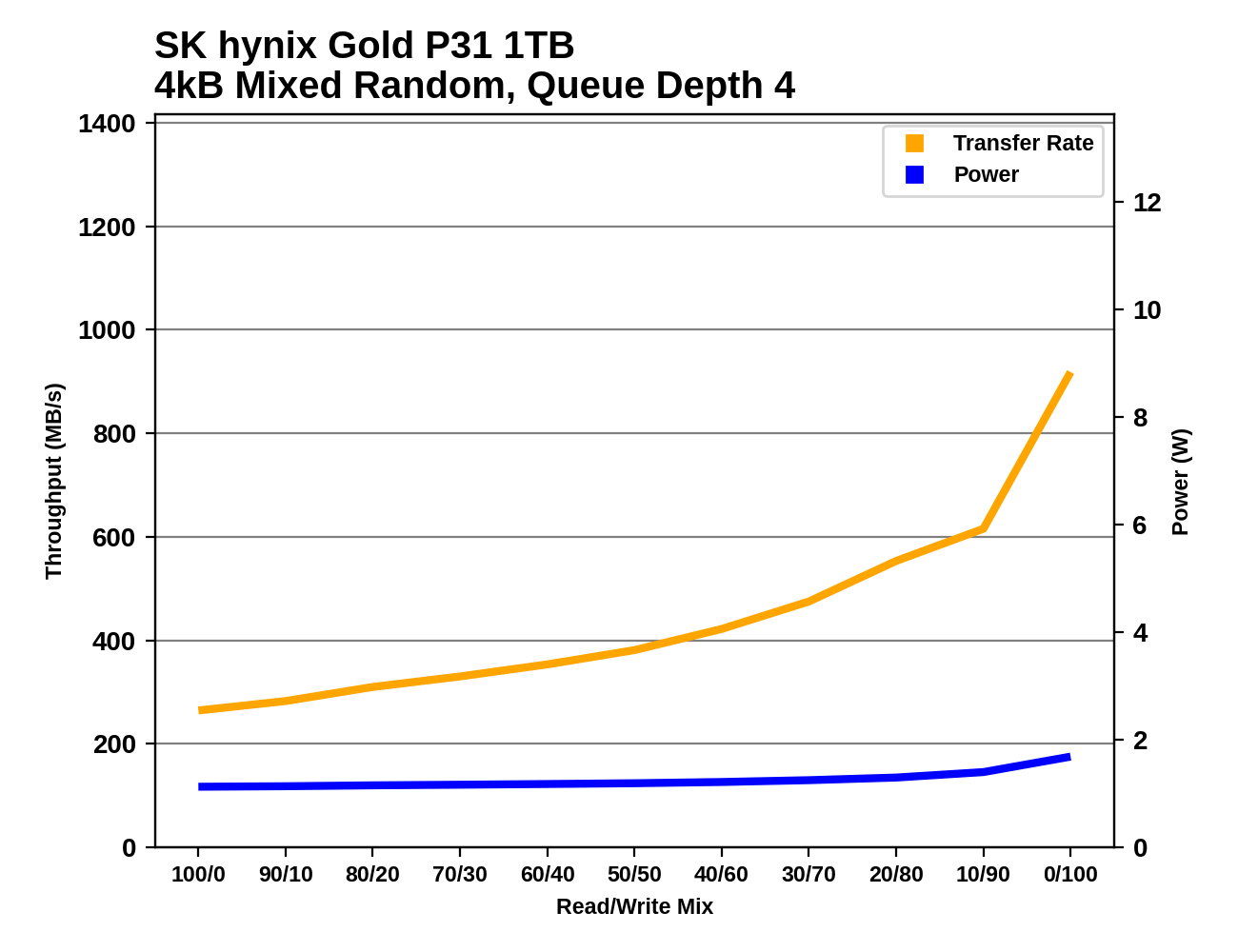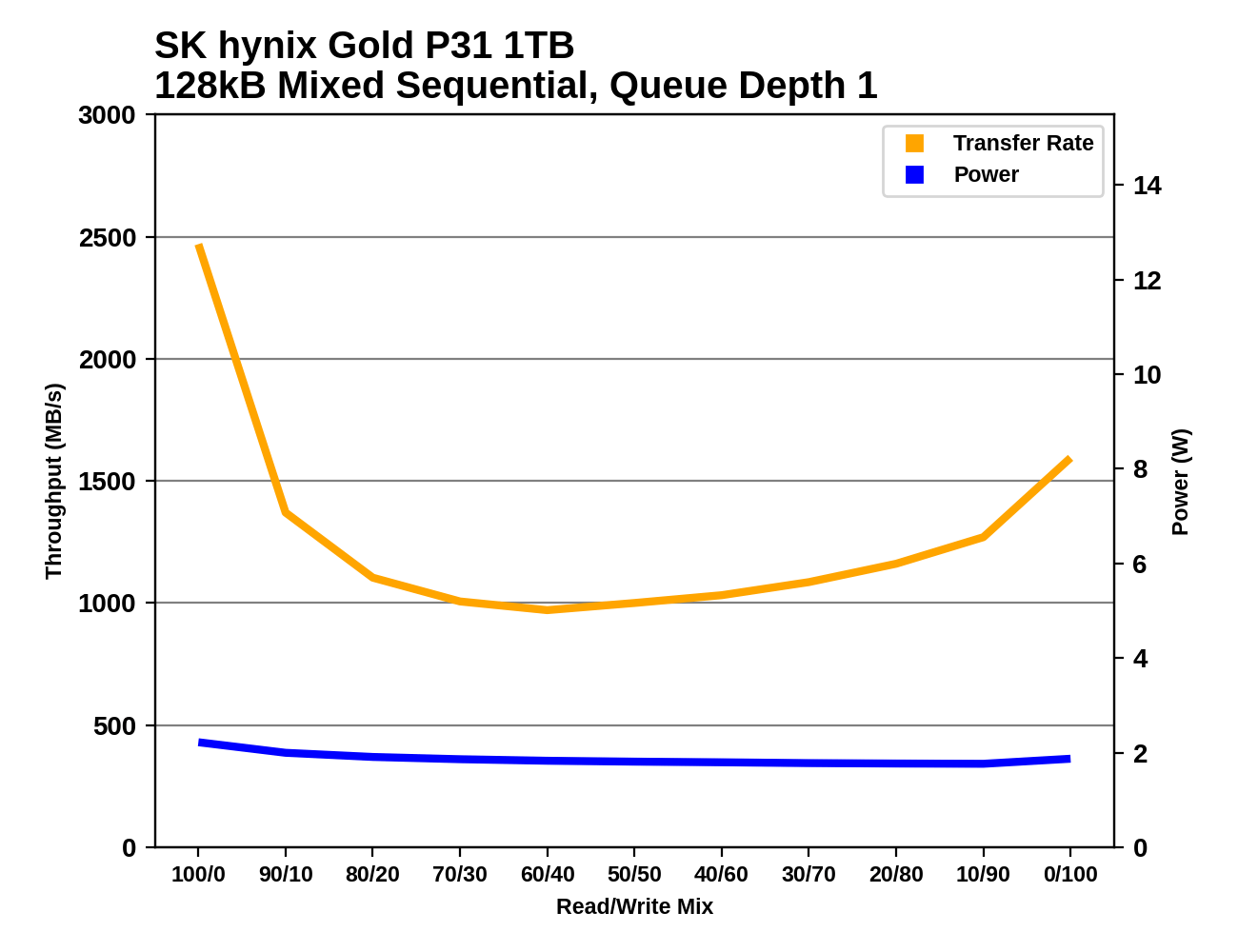The Best NVMe SSD for Laptops and Notebooks: SK hynix Gold P31 1TB SSD Reviewed
by Billy Tallis on August 27, 2020 8:00 AM ESTMixed Random Performance
Our test of mixed random reads and writes covers mixes varying from pure reads to pure writes at 10% increments. Each mix is tested for up to 1 minute or 32GB of data transferred. The test is conducted with a queue depth of 4, and is limited to a 64GB span of the drive. In between each mix, the drive is given idle time of up to one minute so that the overall duty cycle is 50%.

The Intel Optane 905P holds on to a very comfortable performance lead on our mixed random IO test, but the SK hynix Gold P31 raises the bar for TLC-based SSDs by about 10%.
 |
|||||||||
| Power Efficiency in MB/s/W | Average Power in W | ||||||||
The Gold P31 has the lowest average power consumption on this test out of all the drives in this batch, which naturally leads to a massive lead in power efficiency: it delivers twice the performance per Watt of the next best drive.
 |
|||||||||
Compared to other high-end TLC-based SSDs, the Gold P31 performs best during the more read-heavy phases of this test. Several competitors catch up to it and a few surpass it during the most write-intensive portions of the test, but that also tends to be where the P31's power usage advantage is widest.
Mixed Sequential Performance
Our test of mixed sequential reads and writes differs from the mixed random I/O test by performing 128kB sequential accesses rather than 4kB accesses at random locations, and the sequential test is conducted at queue depth 1. The range of mixes tested is the same, and the timing and limits on data transfers are also the same as above.

The mixed sequential read/write performance of the SK hynix Gold P31 is unimpressive. For once, its performance is about what we'd expect from a drive designed more for efficiency than raw performance. However, it still has an 18% lead over the slowest 8-channel drive in this batch.
 |
|||||||||
| Power Efficiency in MB/s/W | Average Power in W | ||||||||
The Gold P31 still completes this test with remarkably low power consumption (averaging less than 2W), but the relatively modest performance means its efficiency score is only about 33% above the next best drive in this bunch.
 |
|||||||||
After starting out with a good sequential read speed, the SK hynix Gold P31's performance drops steeply when writes are added to the mix. It bottoms out just below 1GB/s with a 60% reads mix, and then gradually recovers performance to finish with a fairly typical sequential write speed. Power consumption from the P31 doesn't vary much across the test, and it's only above 2W at the very beginning of the test.










80 Comments
View All Comments
vladx - Thursday, August 27, 2020 - link
I have a SX8200 Pro on my laptop, do I need to enable the laptop Power Management state or is it detected automatically by the firmware?Billy Tallis - Thursday, August 27, 2020 - link
That really depends on what combination of firmware and driver bugs the laptop vendor gave you. But in theory, if the machine originally came with a M.2 NVMe drive, it should have been configured for proper power management and should continue to work well with an aftermarket SSD that doesn't bring any new power management bugs. I think the SX8200 Pro is okay on that score; the slow wake-up times shouldn't prevent the system from trying to use the deep idle states because the drive still promises the OS that it will have reasonable wake-up times.vladx - Thursday, August 27, 2020 - link
My laptop is a MSI Creator 17 that came with a Samsung PM981 drive. Could HWinfo offer any help in identifying the active power states?Billy Tallis - Thursday, August 27, 2020 - link
I'm not sure. I think you can figure out what PCIe power management settings are being used by digging through the PCI configuration space, but I'm not sure how easy it is to get that info while running Windows. As for the NVMe power management settings, my understanding is that it's impossible or very nearly impossible to access that information under Windows, at least with the usual NVMe drivers. The only reliable way I know of to confirm that everything is working correctly to get your SSD idling below 10mW is to have expensive power measurement equipment.vladx - Thursday, August 27, 2020 - link
Ok thanks, Billy. I was going to install Fedora anyways as secondary OS so I guess I'll try the Linux route then.MrCommunistGen - Thursday, August 27, 2020 - link
vladx, I'm really interested in how you go about trying to tease the NVMe power management info out of the drive. I did some internet searches a while back and didn't find anything definitive that I was able to follow and get results from. I've only ever used Debian-based distros, but if you're able to figure it out in Fedora then at least I'll know it is possible.Foeketijn - Thursday, August 27, 2020 - link
Did it happen? Did Samsung finally get an actual competitor? It doesn't really beat the 970 evo that much, so the 970 pro would still be better, but not at this price point, and definitely not with this power usage.Last time intel did that, Samsung suddenly woke up and beat them down again to a place where they stayed since.
Interesting to see what the new evo and pro line will bring.
Not high margin prices this time arround I guess.
LarsBolender - Thursday, August 27, 2020 - link
This has to be one of the most positive AnandTech articles I have read in years. Good job SK Hynix!Luminar - Thursday, August 27, 2020 - link
No recommendation sticker, though.Zan Lynx - Thursday, August 27, 2020 - link
It would be handy if you could add a power loss consistency test. I have a Dell with an older hynix NVMe and one time the battery ran down in the bag, and on reboot its btrfs was corrupt.Imagine these are sequence numbers in metadata blocks.
Correct: 10 12 22 30
Actual: 10 12 11 30
The hynix had committed writes for SOME of the blocks but a few in the middle of the update chain were old versions of the data. According to btrfs flush rules that is un-possible. Which means that the drive reported a successful write for 22 and for 30 but after powerloss recovery it lost that write for 22 and reverted to an older block.
I mean, that's better than some of the older flash drives that would trash the entire FTL and lose all the data. But it is not exactly GOOD.
I'm pretty sure Samsung consumer drives will also lose the data but at least they will revert all of the writes following the lost data, so in my example it would revert write 30 also. That would at least leave things in a logically consistent state.